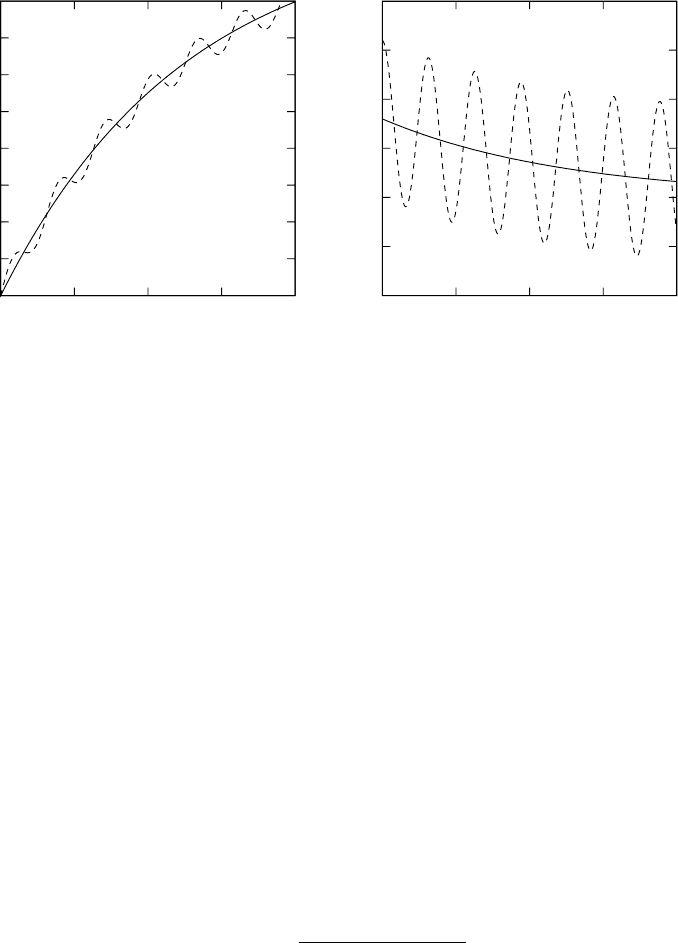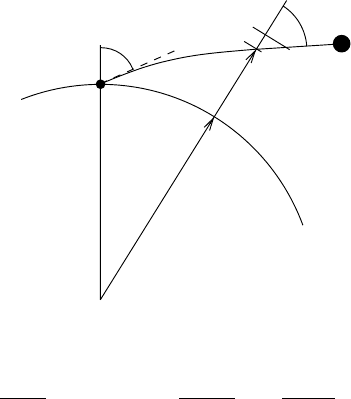Zdunkowski W., Trautmann T., Bott A. Radiation in the atmosphere: A course in Theoretical Meteorology
Подождите немного. Документ загружается.


11.4 Perturbation theory and ozone profile retrieval 435
Next we have to consider the adjoint radiance field I
+
, which is given by the
solution of the adjoint radiative transfer equation
L
+
I
+
(z, Ω) = Q
+
(z, Ω) (11.103)
where Q
+
is the source of adjoint photons, and the adjoint operator L
+
is defined
by
L
+
=−µ
∂
∂z
+k
ext
(z) −
k
sca
(z)
4π
×
4π
P(z, Ω
→ Ω) −
A
g
π
δ(z)U(−µ)|µ|U (µ
)|µ
|
◦ d
(11.104)
Note that in (11.104) as compared to (11.98) the direction µ is inverted. Similarly
to this reversion of the zenith angle the meaning of the boundary conditions for the
adjoint radiance field has to be changed from the incoming forward radiation field
to the outgoing radiance, cf. (5.23)
top of the atmosphere: I
+
(z
t
,µ,ϕ) = 0, 0 ≤ ϕ ≤ 2π,0<µ≤ 1
Earth’s surface: I
+
(0,µ,ϕ) = 0, 0 ≤ ϕ ≤ 2π, −1 ≤ µ<0
(11.105)
We repeat from Chapter 5 the meaning of the pseudo-radiance
(z, Ω) = I
+
(z, −Ω) (11.106)
by pointing out that (z,µ,ϕ) is the solution to the usual forward radiative transfer
equation possessing a particular source
L(z, Ω) = Q
+
(z, −Ω) (11.107)
Again it is noteworthy that for the pseudo-radiance field the direction of the
propagating adjoint photons has to be inverted in the adjoint source Q
+
with respect
to the upper and lower 2π hemisphere. Therefore, the transformation (11.106)
allows us to use the same standard method of finding the solution for the adjoint
radiance field as it is applied for the forward radiance field I (z,µ,ϕ).
Next we wish to illustrate how the first derivative of the reflectance with respect
to the state vector x is related to the perturbation integral. Let us suppose that we
have found the solutions I
0
and I
+
0
for an atmospheric base state (subscript 0)
characterized by the state vector x
0
. Following the procedure outlined in Chapter 5
and resulting in (5.66), the reflectance for a perturbed atmosphere to first-order
accuracy may be approximated by the linear expansion
r(x) ≈ r(x
0
) −
K
k=1
I
+
0
,L
k
I
0
(11.108)

436 Remote sensing applications of radiative transfer
Here L
k
is the change of the differential operator L if we only perturb the k-th
component of the state vector x
0
by x
k
. By comparing this equation with (11.96)
we find for the first derivative of the reflectance r with respect to the physical
parameters x
k
∂r
∂x
k
=−
1
x
k
I
+
0
,L
k
I
0
(11.109)
Our particular interest lies in perturbing either the ozone molecule concentration
ρ
O
3
,k
in units of molecules per m
3
of air in the k-th homogeneous atmospheric
sublayer or the Lambertian albedo A
g
of the ground. For this we derive the first
derivatives of the reflectance with respect to the ozone profile and the surface albedo.
If ρ
O
3
,k
is the mean ozone molecule concentration in the sublayer k and ρ
O
3
,k,0
the corresponding unperturbed value, then the perturbation x
k
is given by
x
k
= ρ
O
3
,k
= ρ
O
3
,k
− ρ
O
3
,k,0
(11.110)
Because we only perturb ρ
O
3
,k
, the change in the absorption optical depth τ
O
3
,k
of sublayer k may be written as
τ
O
3
,k
=
z
k−1
z
k
(ρ
O
3
,k
− ρ
O
3
,k,0
)σ
O
3
,k
dz =−σ
O
3
,k
ρ
O
3
,k
(z
k
− z
k−1
) (11.111)
where σ
O
3
,k
is the absorption cross-section of an ozone molecule and (z
k
, z
k−1
) refer
to the lower and upper boundary of the k-th homogeneous sublayer of the model
atmosphere. Furthermore, we easily see that, for this particular perturbation, L
k
in the perturbation integral (11.108) is
L
k
=
σ
O
3
,k
ρ
O
3
,k
, z
k
< z < z
k−1
0, else
(11.112)
Therefore, we directly find the first derivative of r with respect to the mean ozone
molecule concentration in sublayer k
∂r
∂ρ
O
3
,k
=−
1
ρ
O
3
,k
I
+
0
,L
k
I
0
=−σ
O
3
,k
z
k
z
k−1
4π
0
(z, −Ω)I
0
(z, Ω)ddz
(11.113)
where we have replaced I
+
0
by means of (11.106).
For the perturbation of the surface albedo, A
g
= A
g
− A
g,0
, where A
g,0
is the
Lambertian albedo for the unperturbed ground, we similarly find from (11.98)
L =−
4π
A
g
π
δ(z)U(µ)|µ|U (−µ
)|µ
|◦d
(11.114)

11.4 Perturbation theory and ozone profile retrieval 437
Due to the appearance of the delta function δ(z), the integration over z simpli-
fies to the evaluation of the radiances
0
and I
0
at ground level z = 0. Thus the
corresponding first derivative of r with respect to the surface albedo A
g
is given by
∂r
∂ A
g
=−
1
A
g
I
+
0
,LI
0
=
1
π
E
−
(
0
)E
−
(I
0
)
(11.115)
Here the quantities E
−
(
0
) and E
−
(I
0
) represent downward flux densities at ground
level of the base atmosphere’s pseudo-radiance field
0
(0,) and the forward
radiance field I
0
(0,), respectively, i.e.
E
−
(
0
) =
4π
U (−µ)|µ|
0
(0, Ω)d
E
−
(I
0
) =
4π
U (−µ)|µ|I
0
(0, Ω)d
(11.116)
Note that in these expressions the Heaviside step function U (−µ) just selects all
radiation coming from the upper 2π hemisphere.
Substituting (11.113) and (11.115) into (11.96) yields the reflectance r (x) of the
actual atmosphere as function of the reflectance r(x
0
) of a given base atmosphere.
Landgraf et al. (2001) applied the forward–adjoint perturbation theory to calcu-
late the derivatives of the reflectance with respect to the ozone concentration and
the surface albedo. They also compared the results with benchmark calculations
which have been performed with the DISORT programme package as provided
by Stamnes et al., (1988), see also Section 4. Since in the DISORT calculations
expressions for the partial derivatives of r with respect to ρ
O
3
,k
and A
g
, such as
(11.113) and (11.115), are not available, the following discretizations are used in
these benchmark calculations
∂r
∂ρ
O
3
,k
≈
r(ρ
O
3
,k
+ ρ
O
3
,k
) − r (ρ
O
3
,k
)
ρ
O
3
,k
,
∂r
∂ A
g
≈
r(A
g
+ A
g
) − r (A
g
)
A
g
(11.117)
Figure 11.12a shows the derivatives of r with respect to the ozone concentration.
In the left panel of the figure the vertical profile of ∂r/∂ρ
O
3
has been computed on
the basis of the perturbation theory. These computations have been carried out for
the three wavelengths of 299 (solid), 312 (dotted), and 323 nm (dashed). The figure
has to be interpreted as follows: in regions where the curves attain large values, the
sensitivity of the reflected radiation with respect to a unit ozone perturbation in the
associated altitude range is significant. This is the case for all altitudes above 12 km.
A negative value for ∂r/∂ρ
O
3
means that r decreases if the molecule concentration
of ozone is increased in the particular model layer. For similar perturbations of the
ozone profile in the middle and lower troposphere this sensitivity decreases with

438 Remote sensing applications of radiative transfer
60
40
299 nm
312 nm
323 nm
0
−4 −3 −2 −1 −4 −20024
20
∂r/∂p (10
−16
cm
3
)
δ (10
−2
% )
z (km)
Fig. 11.12 Derivatives ∂r/∂ρ (ρ = ρ
O
3
) as computed with the forward-adjoint
linear perturbation theory. Results are shown for three selected wavelengths λ =
299, 312, 323 nm. The right part of the figure shows the relative difference δ
between the linear perturbation theory and finite difference results obtained with
DISORT. After Landgraf et al. (2001).
decreasing altitude. For the shorter UV wavelengths the clear-sky atmosphere is
optically so thick that photons scattered in the lower part of the atmosphere do not
make any significant contribution to the backscattered light observed by the satellite
instrument. Hence, we conclude that it is rather difficult to retrieve the ozone profile
in the troposphere with satisfactory accuracy.
The right panel of Figure 11.12 depicts the relative difference δ (in 10
−2
%)
between the forward–adjoint approach (11.113) and the finite difference approach
(11.117) based on DISORT calculations. Again the computations have been per-
formed for clear sky conditions involving only Rayleigh scattering and ozone
absorption. The results shown apply to a solar zenith angle of ϑ
0
= 45
◦
and a view-
ing zenith angle of ϑ
v
= 10
◦
. It can be seen that the linear perturbation approach
nearly perfectly reproduces the partial derivatives with relative errors smaller than
about 0.03%.
The upper part of Figure 11.13 shows the sensitivity of the reflectance with
respect to the surface albedo. The solid curve denotes results with a clear sky

11.4 Perturbation theory and ozone profile retrieval 439
λ (nm)
1.5
1.0
0.5
0.0
5
0
−5
−10
300 310 320 330
δ (10
−2
%)
∂r /∂A (1)
Fig. 11.13 Derivatives ∂r/∂ A
g
(upper part with A = A
g
) and relative differ-
ences between the linear perturbation results and the DISORT approach employ-
ing finite differencing (lower part). The parameters for these computations were
ϑ
0
= 45
◦
, ϑ
v
= 10
◦
, and A
g
= 0.1. Solid curves: atmosphere without aerosol
particles, dotted curves: atmosphere containing aerosol particles. After Landgraf
et al. (2001).
atmosphere containing no aerosol particles while for the dotted line a typical rural
aerosol scenario has been adopted. The optical parameters of the aerosol particles
were taken from Shettle and Fenn (1979). For the wavelength of 330 nm the total
aerosol optical depth attained a value of 0.85.
As can be seen from the figure, for the smaller wavelengths ∂r/∂ A
g
converges
to zero. This can be explained by the fact that solar photons do not reach the
surface because they are already absorbed by the stratospheric ozone. This result
has an important consequence: Any ozone data retrieved with a particular inversion
method will turn out to be insensitive to a possibly unknown value of the Lambertian
surface albedo. Thus, regarding the surface properties it would make no difference
if the retrieval is made over the ocean or over a surface covered by snow or ice.
Figure 11.13 also shows that for increasing wavelength ∂r/∂ A
g
increases with λ.
For larger values of λ the wavelength dependence of the sensitivity decreases again.
The lower part of Figure 11.13, depicting the difference between the perturbation
theory and the DISORT approach, reveals that the derivatives of r with respect to
A
g
can be accurately computed with the linear radiative perturbation theory. The
relative errors are always smaller than about 0.05%.

440 Remote sensing applications of radiative transfer
11.5 Appendix
11.5.1 Example for an ill-posed inversion problem
In Section 11.3.1 we have pointed out that due to the quasi-singular matrix A the
solution to (11.61) may become unstable. Now we will illustrate this feature by
virtue of a simple example. Experience with inversion methods tells us that small
perturbations in the observations g may lead to extreme perturbations in the physical
solution f. This is the typical situation in case of ill-posedness. Let us briefly discuss
the definition of a well-posed mathematical problem, see Hansen (1994).
(1) For each g there exists a solution f for which Af = g.
(2) The solution f is unique.
(3) Small perturbations in g cause only small perturbations for the solution f.
If, for a particular problem, one of these conditions is not fulfilled, the problem
is said to be ill-posed. Let us illustrate this with a simple example as discussed by
Craig and Brown (1986). As weighting function or kernel K(x, y) of the integral
equation we use the Heaviside step function
U (y) =
0, y ≤ 0
1, y > 0
(11.118)
The problem to be solved is the Volterra integral equation of the first kind for f (y)
g(x) =
x
a
f (y)dy =
b
a
U (x − y) f (y)dy, x ∈ [a, b] (11.119)
The solution to the inversion problem for (11.119) is simply the first derivative of
the function g
f (y) =
dg
dx
x=y
(11.120)
This can be easily verified by inserting (11.120) into (11.119).
Figure 11.14 depicts the solutions f
a
and f
b
which correspond to the two
‘measurements’
g
a
(x) = 1 − exp
(
−αx
)
g
b
(x) = g
a
(x) +β sin(ωx)
(11.121)
with α = 0.8, β = 0.04 and ω = 20. Note that the term sin(ωx) can be understood
as a small perturbation of the measurement g
a
having an amplitude β. From (11.120)
we find for the solutions of the inversion problem
f
a
(y) = α exp
(
−αy
)
f
b
(y) = f
a
(y) +ωβ cos(ωy)
(11.122)

11.6 Problems 441
0
−1
2
0 0.5 1 1.5 2 0 0.5 1 1.5 2
−0.5
0
0.5
1
1.5
0.8
0.7
0.6
0.5
0.4
0.3
0.2
0.1
Fig. 11.14 Example for an ill-posed inversion problem. The left panel shows the
measurements (solid curve: exact measurement g
a
, dashed curve: measurement
with perturbations g
b
). The right panel depicts the corresponding inversions f
a
and f
b
.
It is clear that the perturbations in g
b
due to the sine term are in the range of a few
percent with respect to the measured unperturbed signal g
a
. Nevertheless, for y > 1
the perturbations in the solution f
b
can amount to several 100% of the true solution
f
a
, see Figure 11.12. Therefore, the solution of the inversion problem (11.119)
becomes already unstable for small changes in the observation g.
The typical situation in inverse remote sensing problems is that, unlike to the
simple case above, it is not possible to find full analytical solutions of the Fredholm
integral equation by virtue of complete function systems (e.g. orthogonal polyno-
mials). Therefore, one formulates the inverse problem in its discretized form and
searches for a solution employing methods of linear algebra.
11.6 Problems
11.1: Show that in the Bouguer–Langley method the slope of the regression line
is given by
τ
λ
=
ln(E
λ,2
) − ln(E
λ,1
)
m
1
− m
2
11.2: Suppose that the absorption coefficient decreases with height according
to k(z) = k(z = 0) exp(−z/H) where H is a positive constant. Find the
height where the weighting function has its maximum. Assume that the
transmission function follows an exponential law.

442 Remote sensing applications of radiative transfer
11.3: By carrying out the matrix multiplications, show that (11.70) is equivalent
to (11.67).
11.4: Verify (11.80).
11.5: Formula (11.7) is purely empirical. A suitable air mass formula for dry air
scattering can be derived with the help of the figure below, the definition
m = (
∞
0
ρds)/(
∞
0
ρdz) and the basic astronomic formula (1 + δ)(R +
z) sin ζ = con s t, see the figure.
Sun
Observer
R
z
dz
ds
ζ
0
ζ
Show that
m =
1
ρ
0
H
0
∞
0
ρ
1 −
1 + δ
0
1 + δ
2
R
R + z
2
sin
2
ϑ
0
−1/2
dz
with H
0
= p
0
/(gρ
0
) and N = 1 + δ is the index of refraction of the air.
The suffix 0 refers to the ground. Usually one assumes that δ/δ
0
= ρ/ρ
0
.
12
Influence of clouds on the climate of the Earth
In the final chapter of this book we will briefly treat the radiative influence of
clouds on the climate of the Earth. A brief introduction to this topic has already
been presented in the first chapter where we have discussed the radiation budget of
the Earth. In the chapters that followed we have studied the radiative transfer theory
in some detail and have learned how to calculate the radiances and flux densities in
the solar and long-wave spectrum.
We have omitted any discussion of measurement programs such as the satellite
experiments ERB and ERBE which were specifically devised to study the global
radiation budget. A brief description of some of the sophisticated instrumentation
used to measure the reflected solar energy and the outgoing long-wave radiation is
given by Lenoble (1993) where many references to this topic can be found.
Globally the planet Earth is in radiative equilibrium implying that the reflected
solar radiation and the outgoing long-wave radiation are in balance with the incom-
ing solar radiation. If this balance is disturbed by natural or by anthropogenic pro-
cesses the global climate will be changed. A detailed study of the radiative impact
of clouds on the climate is very difficult and can be carried out only with the help
of sophisticated climate models. The reason for this is that many different variables
that are responsible for the evolution of the climate interact in a highly nonlinear
way. Here we will give a very simple discussion only following the arguments
presented by Arking (1991).
12.1 Cloud forcing
The outgoing long-wave radiation E
l,t
at the top of the atmosphere can be calculated
with the help of one of the radiative transfer methods which we have previously
discussed. Accepting the insufficiency of any empirical formula, we use the Budyko
443

444 Influence of clouds on the climate of the Earth
expression
E
l,t
= 223.0 + 2.2T
0
− (48.0 + 1.6T
0
)C (12.1)
to calculate E
l,t
where T
0
is the air temperature near the ground and C the cloud
fraction ranging from 0 to 1. In order to obtain E
l,t
in units of (W m
−2
), the tem-
perature T
0
must be expressed in degrees Celsius. The variation of E
l,t
with cloud
fraction C results in the so-called sensitivity coefficient for long-wave radiation δ
l
as defined by
δ
l
=
∂ E
l,t
∂C
=−(48.0 + 1.6T
0
) (12.2)
For a constant mean global surface temperature T
0
= 15
◦
C, δ
l
assumes the value
of −72 W m
−2
.
Analogously, the sensitivity coefficient for solar radiation δ
s
can be defined by
considering the solar flux density E
s,t
at the top of the atmosphere. If A
C
stands
for the average albedo of the overcast sky, A
0
for the albedo of the cloud-free
atmosphere then E
s,t
is expressed by
E
s,t
=
S
0
4
(1 − A) =
S
0
4
[
1 − A
C
C − A
0
(1 − C)
]
(12.3)
where A = A
C
C + A
0
(1 − C) is a weighted average global albedo with the cloud
fraction as weighting factor. In analogy to (12.2) the sensitivity coefficient for solar
radiation δ
s
is defined by
δ
s
=
∂ E
s,t
∂C
=−
S
0
4
(A
C
− A
0
) (12.4)
Assuming S
0
=1368 W m
−2
, A
C
= 0.5 and A
0
= 0.12 which appear to be reason-
able values, the sensitivity coefficient is δ
s
=−130Wm
−2
.
Let us now briefly discuss the effect of clouds on the radiation budget at the top
of the atmosphere. As follows from (12.3) and simple reasoning, an increase in
cloud fraction C increases the reflectance at the top of the atmosphere level thus
reducing the energy gain for the system Earth–atmosphere. However, an increase
in cloud fraction also reduces the outgoing long-wave radiation at the top of the
atmosphere because clouds are colder than the Earth’s surface. This fact is also
stated by the minus sign of the last term of (12.1).
We will now introduce the net sensitivity coefficient which is the difference
between the solar and long-wave radiation sensitivity coefficients as expressed by
δ = δ
s
− δ
l
=
∂ E
s,t
∂C
−
∂ E
l,t
∂C
=−
S
0
4
(A
C
− A
0
)
1 −
∂ E
l,t
∂C
∂ E
s,t
∂C
(12.5)
Thus, δ amounts to −58 W m
−2
. Certainly, this number is no more than a crude
estimate, but it gives us an impression of the order of magnitudes which are involved.
